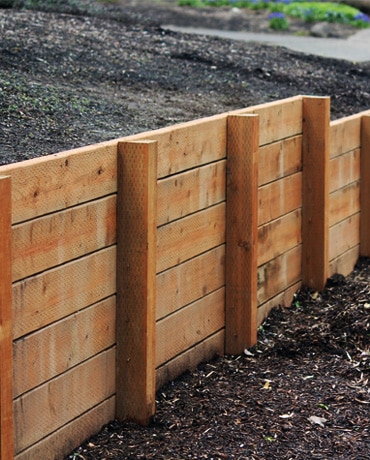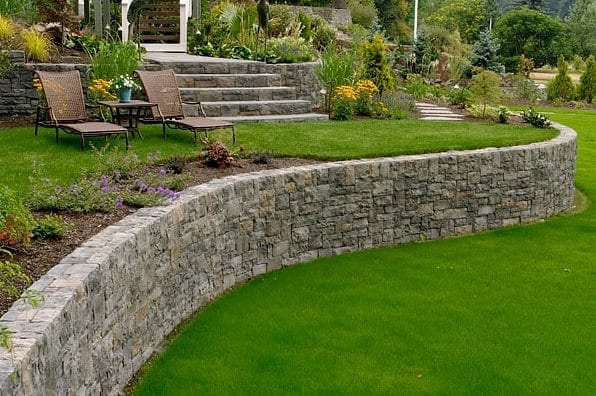Ensuring Structural Integrity: The Value of Correctly Constructed Retaining Wall Surfaces in Preventing Incline Failure
In the world of civil design and building and construction, the relevance of appropriately built retaining walls in preventing slope failing can not be downplayed. These structures act as critical safeguards versus the natural forces that can undercut slopes and trigger possibly disastrous repercussions. Recognizing the meticulous design considerations, building and construction techniques, and upkeep methods connected with preserving wall surfaces is essential in guaranteeing their effectiveness and durability. By discovering the intricate interaction in between these components, a deeper understanding of the crucial duty that retaining walls play in preserving structural stability and avoiding incline failure arises. Retaining Walls Sunshine Coast.
Function of Retaining Walls in Stability
The indispensability of retaining wall surfaces in making sure slope security is paramount in civil design practices. Keeping wall surfaces serve an important function in stopping soil disintegration, taking care of water overflow, and maintaining the structural stability of slopes. By supporting vertical or near-vertical quality adjustments, retaining walls help to rearrange lateral stress put in by the dirt, consequently decreasing the threat of slope failing.
One trick function of maintaining walls is to combat the pressure of gravity acting on the dirt mass behind them. This is attained with appropriate design and construction, which considers aspects such as soil type, wall surface elevation, water drainage arrangements, and prospective additional charge lots. By effectively retaining dirt within specified boundaries, these structures aid to maintain slopes and protect against landslides.
Furthermore, keeping walls add to the aesthetic appeals of landscapes while supplying functional advantages. They can develop terraced degrees for landscaping, support roadways or frameworks on hills, and improve the overall usability of sloped terrain. Basically, keeping wall surfaces play a vital function in maintaining incline security and making sure the security and longevity of civil design tasks.
Variables Affecting Wall Surface Effectiveness
Aspects that influence the efficiency of retaining wall surfaces include soil properties, wall layout, and external loads. Dirt residential or commercial properties play a critical function in determining the stability and performance of a preserving wall. Aspects such as dirt type, cohesion, internal friction angle, and groundwater problems can impact how well a wall retains the soil behind it. The style of the maintaining wall is an additional key aspect that affects its effectiveness. Appropriate wall surface layout takes into consideration aspects like wall surface height, wall surface type (e.g., gravity walls, cantilever wall surfaces), reinforcement products, water drainage systems, and construction strategies to make certain the wall surface can withstand the side pressure exerted by the preserved dirt. Additionally, external loads, such as surcharge tons from adjacent structures or website traffic, seismic forces, and water stress, must be very carefully assessed during the design and building and construction phases to make certain the wall surface can appropriately withstand these external forces. By thinking about these factors comprehensively, engineers can build preserving walls that successfully protect against slope failure and make sure lasting architectural stability.
Layout Factors To Consider for Keeping Wall Surfaces
Incorporating the important elements of soil buildings and external loads into the structural style procedure is necessary for creating efficient preserving walls that guarantee slope stability. When making preserving walls, designers must thoroughly review the features of the bordering soil, including its compaction, drainage, and kind residential or commercial properties. Understanding these dirt residential properties is vital for determining the appropriate wall reinforcement, density, and elevation needed to hold up against the side pressure applied by the soil pop over here mass.
Additionally, external lots such as surcharge tons from neighboring frameworks or website traffic, as well as seismic forces, should be taken right into account throughout the layout phase. These lots can considerably impact the security and efficiency of a keeping wall, demanding the usage of correct design techniques and products to mitigate possible failure risks.
Additionally, the option of ideal products, such as concrete, stone, or lumber, must straighten with the aesthetic needs and site-specific conditions. Element of security considerations, water drainage stipulations, and construction methods are also crucial facets that influence the general style and functionality of preserving wall surfaces in avoiding slope failing. By thoroughly taking into consideration these design considerations, designers can make certain the architectural integrity and long-term security of retaining wall surfaces.

Construction Best Practices for Resilience
When creating retaining wall surfaces for ideal sturdiness and longevity, adherence to industry-standard methods and precise interest to detail are paramount. To guarantee the sturdiness of a preserving wall, appropriate website prep work is crucial. This includes appropriate compaction of the soil, proper drainage systems, and guaranteeing the wall surface's foundation is audio. Utilizing top quality products, such as cinder blocks or all-natural stone, is vital for the longevity of the structure. In addition, employing experienced professionals with experience in creating maintaining walls can considerably affect the toughness of the last item.
Incorporating support strategies, such as geogrids or steel bars, can enhance the structural honesty of the retaining wall and avoid potential failures. By complying with these construction finest methods, maintaining wall surfaces can stand up to the test of time and successfully protect against slope failing.
Relevance of Appropriate Upkeep
Regular maintenance is crucial for preserving the architectural stability and performance of preserving wall surfaces over time. To make sure that maintaining walls continue to execute their desired function successfully, normal assessments must be conducted to recognize any indicators of wear and tear.

Conclusion
In verdict, preserving walls play an important duty in guaranteeing architectural honesty and preventing slope failure. By taking into consideration variables affecting wall surface effectiveness, sticking to design factors to consider, complying with building best methods, and applying proper upkeep, the longevity of maintaining walls can be maximized. Retaining Walls Sunshine Coast. It is important to recognize the significance of appropriately built preserving walls in preserving security and stopping potential risks related to incline failure
Variables that influence the efficiency hop over to these guys of keeping wall surfaces consist of dirt properties, wall design, and outside loads. Proper wall style thinks about factors like wall surface height, wall type (e.g., gravity walls, cantilever walls), support products, drainage systems, and building techniques to ensure the wall surface can withstand the side stress applied by the kept dirt. By taking into consideration these elements adequately, engineers can construct maintaining wall surfaces that effectively avoid slope failing and ensure long-term structural honesty.
Maintenance tasks may include removing drain systems to avoid water accumulation behind the wall, fixing any noticeable splits or damages, and guaranteeing that the wall surface is totally free from plant life that might put in pressure on the structure. By considering elements influencing wall performance, adhering to make factors to consider, following construction best practices, and carrying out proper maintenance, the durability of keeping wall surfaces can be optimized.
Comments on “How Retaining Walls Sunshine Coast Include Value and Capability to Your Residential property”